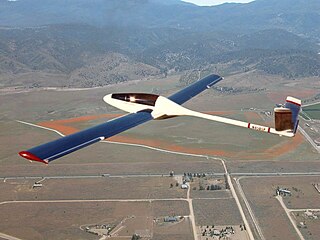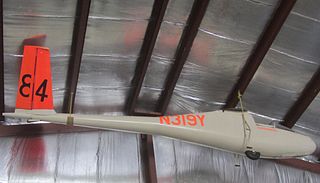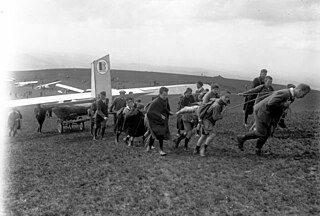
The Monnett Monerai is a sailplane that was developed in the United States in the late 1970s for homebuilding. It is a conventional pod-and-boom design with a V-tail and a mid-mounted cantilever wing of constant chord.
Richard E. Schreder was an American naval aviator and sailplane developer, responsible for design and development of the HP/RS-series kit sailplanes marketed from 1962 until about 1982. Schreder also founded and ran Airmate, a successful drafting supplies company.

The HP-18 is a Richard Schreder-designed metal Racing Class sailplane that was offered as a kit for homebuilding during the 1970s and 1980s.

The HP-14 is a Richard Schreder-designed all-metal glider aircraft that was offered as a kit for homebuilding during the 1960s and 1970s. It was originally developed by retrofitting improved wings to the fuselage and tail of the HP-13, and first flew in 1966. Schreder won the 1966 US national soaring championship in the prototype HP-14.

The Bowlus/Nelson BB-1 Dragonfly is an American, two seat, strut-braced, high-wing motor glider that was developed from the Bowlus BA-100 Baby Albatross glider by Hawley Bowlus.

The Rutan Model 77 Solitaire is an American, single seat, canard, mid-wing motor glider that was developed by Burt Rutan in response to the 1982 Sailplane Homebuilders Association Design Contest for a homebuilt glider. It first flew in 1982. The Solitaire was declared the winner of the contest and its unusual layout attracted a great deal of attention. For a time in the 1980s the aircraft was available as plans and as a kit.

The Schreder Airmate HP-10 is an American, high wing, single seat, FAI Standard Class glider that was designed by Richard Schreder. Airmate was the name of Schreder's design company.

The Schreder Airmate HP-11 is an American mid-wing, V-tailed, single seat glider designed by Richard Schreder. Airmate was the name of Schreder's design company.
The Schreder HP-16 is an American mid-wing, single seat, V tailed, FAI Standard Class glider that was designed by Richard Schreder.

The Schreder HP-17 was an American mid-wing, V tailed, single seat, experimental glider designed by Richard Schreder to test a new airfoil section.
The Schreder HP-19 is an American, high-wing, T-tail, single seat glider designed by Richard Schreder.
The Schreder HP-22 was an American mid-wing, amphibious flying boat, cruciform tailed, two seat motor glider project that was designed by Richard Schreder. None were ever completed or flown.

The Bowlus BZ-1 is an American single seat FAI 15 Meter Class, V-tailed glider that was designed and built by Michael Bowlus.
The Schmutzhart SCH-1 is an American high-wing, single-seat, T-tailed glider that was designed and built by Berthold Schmutzhart.
The Zauner OZ-5 One-Yankee is an American high-wing, T-tailed, single seat, 15 metre class glider that was designed and constructed by Otto Zauner.
The Strojnik S-2 is an American high-wing, single-seat motor glider that was designed and built by Aleš Strojnik.

The Akaflieg Darmstadt D-9 Konsul, often shortened to Darmstadt D-9 Konsul, was a high performance, single seat, cantilever monoplane sailplane, designed and built by a German University student group in 1923 for hill soaring.
The VFW-Fokker FK-3 is a single seat competition glider, built in Germany in the late 1960s. It had success at the Italian and Austrian national contests of 1968, resulting in a short production run the following year.
The Schneider ES-54 Gnome was an experimental low cost glider with a laminar flow but low aspect ratio wing, built in Australia in the mid-1950s. Its performance was predictably poor and only one was completed.
The Weber-Landholf-Münch WLM-1 is a 1940s Swiss high performance sailplane designed to meet a Swiss Air Force (SAF) requirement for a training glider that could initiate potential fighter pilots. To this end it is fast, aerobatic and equipped with standard military instrumentation. Only three were built.










